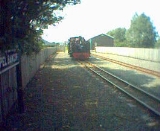
Capel Bangor railway station
Encyclopedia
Capel Bangor railway station is a railway station serving Capel Bangor
in Ceredigion
in Mid-Wales. It is an intermediate station on the preserved Vale of Rheidol Railway
. The station limits are clearly defined by fencing and identified by name signs. Facilities include a passing loop
(allowing two trains to pass in opposite directions, or the locomotive to run round a train that is changing direction of travel), and sidings which also link the main running line with a large train shed.
 The village community at Capel Bangor was once much larger than it is today, and in the earliest days of the Vale of Rheidol Railway Capel Bangor was the third principal station along with the two termini. It had a resident Station Master, and was equipped with waiting shelters, booking office, passing loop, sidings, and a large carriage shed. These facilities were all removed with the gradual decline of the village population, although in the 1980s British Rail
The village community at Capel Bangor was once much larger than it is today, and in the earliest days of the Vale of Rheidol Railway Capel Bangor was the third principal station along with the two termini. It had a resident Station Master, and was equipped with waiting shelters, booking office, passing loop, sidings, and a large carriage shed. These facilities were all removed with the gradual decline of the village population, although in the 1980s British Rail
, then the operators of this line, rebuilt a stone waiting shelter, and provided a picnic area for passengers alighting from trains here.
In 2001 the new operator embarked upon a process of restoration of operating facilities at Capel Bangor. The passing loop was restored, as was a single carriage siding, accessed 'out and back' via a lengthy headshunt
. Subsequently the 1980s waiting shelter was demolished, but the single carriage siding was joined by a second, parallel line (accessed via the same headshunt), and a large modern train shed was constructed. Both stock sidings run into this shed, and there is a pedestrian access door at its opposite end, but there are no windows. Immediately prior to the train shed's construction the carriage siding at Capel Bangor was used for the storage of some stock items belonging to the Phyllis Rampton Trust
, who are the 100% shareholders of the railway's operating company. The 'secret location in Ceredigion' wherein many stock items belonging to this Trust are stored, is likely to be the new Capel Bangor train shed.
The passing loop is not currently required for purposes of operating the timetabled service trains, even on the high season timetable. However, the loop has proved useful for allowing service trains to cross with specially chartered passenger trains and with works (maintenance) trains. The principal use, however, has been as a run-round loop for locomotives involved with bringing rolling stock to or from the new train shed.
Capel Bangor
Capel Bangor is a small village in Ceredigion, in Wales. It is approximately five miles from the seaside and university town of Aberystwyth.-Facilities:The size of the village of Capel Bangor decreased during the twentieth century, and facilities are limited...
in Ceredigion
Ceredigion
Ceredigion is a county and former kingdom in mid-west Wales. As Cardiganshire , it was created in 1282, and was reconstituted as a county under that name in 1996, reverting to Ceredigion a day later...
in Mid-Wales. It is an intermediate station on the preserved Vale of Rheidol Railway
Vale of Rheidol Railway
The Vale of Rheidol Railway is a narrow-gauge gauge heritage railway that runs for between Aberystwyth and Devil's Bridge in the county of Ceredigion, Wales...
. The station limits are clearly defined by fencing and identified by name signs. Facilities include a passing loop
Passing loop
A passing loop is a place on a single line railway or tramway, often located at a station, where trains or trams in opposing directions can pass each other. Trains/trams in the same direction can also overtake, providing that the signalling arrangement allows it...
(allowing two trains to pass in opposite directions, or the locomotive to run round a train that is changing direction of travel), and sidings which also link the main running line with a large train shed.
History and Description

British Rail
British Railways , which from 1965 traded as British Rail, was the operator of most of the rail transport in Great Britain between 1948 and 1997. It was formed from the nationalisation of the "Big Four" British railway companies and lasted until the gradual privatisation of British Rail, in stages...
, then the operators of this line, rebuilt a stone waiting shelter, and provided a picnic area for passengers alighting from trains here.
In 2001 the new operator embarked upon a process of restoration of operating facilities at Capel Bangor. The passing loop was restored, as was a single carriage siding, accessed 'out and back' via a lengthy headshunt
Headshunt
A headshunt is a short length of track, provided to release locomotives at terminal platforms, or to allow shunting to take place clear of main lines.- Terminal Headshunts :...
. Subsequently the 1980s waiting shelter was demolished, but the single carriage siding was joined by a second, parallel line (accessed via the same headshunt), and a large modern train shed was constructed. Both stock sidings run into this shed, and there is a pedestrian access door at its opposite end, but there are no windows. Immediately prior to the train shed's construction the carriage siding at Capel Bangor was used for the storage of some stock items belonging to the Phyllis Rampton Trust
Phyllis Rampton Trust
The Phyllis Rampton Narrow Gauge Railway Trust is a British charity which is registered with the British Charity Commission as 292240 under the classification of "Education/TrainingEnvironment/Conservation/Heritage"...
, who are the 100% shareholders of the railway's operating company. The 'secret location in Ceredigion' wherein many stock items belonging to this Trust are stored, is likely to be the new Capel Bangor train shed.
The passing loop is not currently required for purposes of operating the timetabled service trains, even on the high season timetable. However, the loop has proved useful for allowing service trains to cross with specially chartered passenger trains and with works (maintenance) trains. The principal use, however, has been as a run-round loop for locomotives involved with bringing rolling stock to or from the new train shed.

